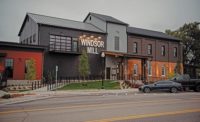The 54.5-Hour Fix: NB-360 Bridge Rehabilitation Project at MP A58.88
South Whitehall Township, Pa.
BEST PROJECT
Owner: Pennsylvania Turnpike Commission
Lead Design Firm: Borton-Lawson
General Contractor: J.D. Eckman Inc.
After more than 60 years in service, the aging superstructure of a 90-ft-long bridge that carried Interstate 476 over State Route 309 near Allentown, Pa., had reached the end of its life. The Pennsylvania Turnpike Commission selected an accelerated bridge construction (ABC) delivery method to ensure a swift replacement for a bridge that would carry roughly 30,000 vehicles per day. By using an accelerated method, the team determined that a new bridge could be installed within a 55-hour window over the weekend of Sept. 6-9, 2019. During that window, I-476 and SR 309 would be closed. The project marked the third time the PTC had closed the turnpike to use ABC techniques for bridge replacement.
The superstructure design consisted of 12 steel girders. The design-build team of Borton-Lawson and J.D. Eckman devised the bridge in four separate three-girder sections. To ensure the accuracy of construction, Borton-Lawson used 3D scanning of the existing bridge to confirm location of the existing bridge and bridge seats.
The new bridge superstructure was built in an abandoned lot behind a building located approximately 500 ft from the bridge. Temporary abutments were built at J.D. Eckman’s precasting plant to dimensions that matched the existing abutments.
Before transporting components to the existing bridge location, deck elevations were surveyed in the field and verified. BortonLawson checked the design deck elevations against the as-built elevations to make sure the bridge was constructed to the proper dimensions.
Once traffic was closed and the site prepared, J.D. Eckman’s crews removed the existing beams and deck—from abutment to abutment—in one pick using a Liebherr 1300 crane, which has a maximum capacity of 300 tons. The piece was set on self-propelled modular transporters and moved to an offsite location, where it could be demolished.
With the existing superstructure removed, the bridge’s new elements were brought on site using the same self-propelled modular transporters. The Liebherr 1300 was used to set the bridge in place.
Anticipating the need for expedited engineering consultation on various items over the course of the weekend, the team had two registered bridge engineers on site during the full closure to provide engineering support, as needed.
The team successfully replaced the superstructure in 54.5 hours—a half-hour ahead of the deadline. Throughout the project—including months prior to installation—local townships, essential services and the general public were kept informed about the closures and available detours.
Given the level of precision and coordination required, one judge said, “For me, it was a head above” the other projects in this year’s competition.








Post a comment to this article
Report Abusive Comment